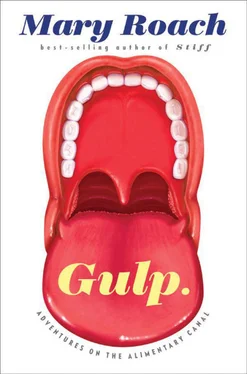Humans, even physiologists, don’t like to think about food once they’ve begun to process it. The same chanterelle and Gorgonzola galette that had the guests swooning is, after two seconds in the mouth, an object of universal revulsion. No one knew this more intimately than Tom Little, an Irish American laborer who ate his meals by chewing food and spitting it into a funnel that fed into his stomach. When he was nine years old, in 1895, Tom swallowed a draught of clam chowder without letting it cool. The burn healed with strictures that fused the walls of his esophagus. Surgeons created a fistulous opening to his stomach so he could eat—or “feed,” as Tom now referred to the act of taking in sustenance. It was an undiminishing source of embarrassment. (Interestingly, his doctor noted in a book about the case, Tom “blushed both in his face and his gastric mucosa.”) He told no one, and took his meals alone or with his mother. When he finally married, it was to an older woman for whom he felt little attraction. He chose her, he told his doctor, because “she doesn’t mind the way I feed.”
In the bulimic community, the weight-loss strategy known as “chewing and spitting” (or CHSP) is by far the least popular. Only 8 percent of bulimic patients seen at the Eating Disorders Clinic at the University of Minnesota reported having engaged in CHSP more than three times a week—usually resorting to it only if they were unable to make themselves vomit, or because regurgitated stomach acid was damaging their teeth or esophagus. Rarely would the study’s author, Jim Mitchell, encounter a patient “whose sole problem is chewing and spitting.”
Of all the unflattering and untrue stories printed in the tabloids about Elton John over the years, this one drove him to sue: “Rock star Elton John’s weight has plunged… thanks to a bizarre new habit of eating food then spitting it out.” The article, which ran in London’s Sunday Mirror in 1992, described him at a holiday party at his manager’s home, spitting chewed shrimp into a napkin, commenting gaily, “‘I love food,… but what’s the point of swallowing it, you can’t taste it as it goes down your throat.’” The editors admitted to having fabricated the story but didn’t feel John had been defamed. The jury disagreed, awarding the singer £350,000—about $570,000—in damages.
Disgust and shame don’t fully account for the unpopularity of CHSP. This does: chewing without swallowing is not eating. It doesn’t scratch the itch. That’s the point of swallowing it, made-up Elton: satisfaction. As regards eating, Mitchell told me, there’s an imaginary line at the esophagus. “Everything happening above the neck—smelling, tasting, seeing—drives you toward eating, and everything below drives you toward stopping.” Chewing causes saliva to be secreted, which dissolves the food and brings more of it in contact with the taste buds. Taste receptors recognize salts, sugars, fats, the things bodies need to thrive, and impel us to stock up. As the stomach fills and satiety grows, the head pipes down. Presently the plate is pushed away. When you chew food without swallowing it, the line at the neck is never crossed. The head keeps up its clamor.
Which brings us to another reason the incidence of CHSP is so low. It’s expensive. Some of the women Mitchell interviewed would catch and release several dozen doughnuts at a go, flushing twenty-plus dollars down the toilet.
JIANSHE CHEN CAN tell you the flow speed of a high-viscosity bolus. [53] Assuming equal terrain and baggage count, about as fast as a tortoise—.22 miles per hour.
He knows the shear strength of a ricotta-cheese bolus, the deformability of Nutella, the minimum number of chews required to ready a McVitie’s Digestive biscuit for the swallow (eight). On the Internet I found a copy of Chen’s PowerPoint on the “dynamics of bolus formation and swallowing,” so I too know these things. What I don’t know is the point of it all. Chen made the mistake of putting his University of Leeds e-mail address on the website.
He wrote back right away. You get the sense oral processing experts are not, generally speaking, besieged by media inquiries. The aim of the work, he said, is to “provide guidance on how to formulate foods for safe eating by disadvantaged consumers.” Bolus formation and swallowing depend on a highly coordinated sequence of neuromuscular events and reflexes. Disable any one of these—via stroke, degenerative neurological condition, tumor irradiation—and the seamless, moist ballet begins to fall apart. The umbrella term is dysphagia (from the Greek for “disordered eating,” which may or may not explain flaming Greek cheese appetizers).
Most of the time, while you’re just breathing and not swallowing, the larynx (voice box) blocks the entrance to the esophagus (food tube). When a mouthful of food or drink is ready to be swallowed, the larynx has to rise out of the way, both to yield access to the esophagus and to close off the windpipe and prevent the food from being inhaled. To allow this to happen, the bolus is held momentarily at the back of the tongue, a sort of anatomical metering light. If, as a result of dysphagia, the larynx doesn’t move quickly enough, the food can head down the windpipe instead. This is, obviously, a choking hazard. More sinisterly, inhaled food and drink can deliver a troublesome load of bacteria. Infection can set in and progress to pneumonia.
A less lethal and more entertaining swallowing misstep is nasal regurgitation. Here the soft palate—home turf of the uvula, [54] Its full medical name, and my pen name should I ever branch out and write romance novels, is palatine uvula.
that queer little oral stalactite—fails to seal the opening to the nasal cavity. This leaves milk, say, or chewed peas in peril of being horked out the nostrils. Nasal regurgitation is more common with children, because they are often laughing while eating and because their swallowing mechanism isn’t fully developed.
“Immature swallowing coordination” is the reason 90 percent of food-related choking deaths befall children under the age of five. Also contributing: immature dentition. Kids grow incisors before they have molars; for a brief span of time they can bite off pieces of food but cannot chew them. Round foods are particularly treacherous because they match the shape of the trachea. If, say, a grape goes down the wrong way, it blocks the tube so completely that no breath can be drawn around it. A child is better off inhaling a plastic barnyard animal or toy soldier, because air can be inhaled through its legs or around its rifle. Hotdogs, grapes, and round candies take the top three slots in a list of killer foods published in the July 2008 issue of the International Journal of Pediatric Otorhinolaryngology , itself a calamitous mouthful. Jennifer Long, a professor of head and neck surgery at the University of California, Los Angeles, went so far as to declare hotdogs a public health issue. A candy called Lychee Mini Fruity Gels has killed enough times for the U.S. Food and Drug Administration to have banned its import.
Every now and then a food comes along that is so difficult to orally process that even healthy adults without dysphagia have trouble getting it down. Sticky rice mochi, a traditional Japanese New Years food, kills about a dozen people every year—along with puffer fish and flaming cheese, the world’s riskiest menu items.
The safest foods, of course, are those that arrive on the plate premoistened and machine-masticated, leaving little for your own built-in processor to do. They are also, generally speaking, the least popular. Mushy food is a form of sensory deprivation. In the same way that a dark, silent room will eventually drive you to hallucinate, the mind rebels against bland, single-texture foods, edibles that do not engage the oral device. Mush is for babies. Those who can, want to chew. The story of U.S. military rations bears this out. During World War II, when combat rations were tinned, meat hashes were a common entrée because they worked well with the filling machines. “But the men wanted something they could chew, something into which they could ‘sink their teeth,’” wrote food scientist Samuel Lepkovsky in a 1964 paper making the case against a liquid diet for the Gemini astronauts. He summed up the soldiers’ take on potted meat: “We could undoubtedly survive on these rations a lot longer than we’d care to live.” (NASA went ahead and tested an all-milkshake meal plan on groups of college students living in a simulated space capsule at Wright-Patterson Air Force Base in 1964. A significant portion of it ended up beneath the floorboards.)
Читать дальше












